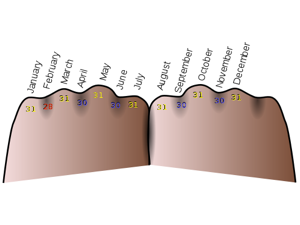Published on Sunday, December 26, 2010 in
downloads,
fun,
magic,
products,
software
 How many of you got that long-awaited techno-gadget phone or tablet during the holidays which you've been waiting for?
How many of you got that long-awaited techno-gadget phone or tablet during the holidays which you've been waiting for?
Since you probably built it up into a magical level in your mind before you got it, how about taking it to magical levels now that you have it?
To start, go over to Andrew Mayne's iPod Tricks site. Despite the name, most of the tricks are most image- or video-based, so they're easily adaptable to any handheld mobile device. In EZ Money, you can pull real money off an image of a dollar bill, with a comedic ending. Weapon X is more of an interlude in which you x-ray your arm, to show your built-in claws, just like Wolverine.
Among the more unusual tricks on that site, there's Spirit Photo, a supernatural-themed trick done with another person's mobile-device (must have internet access for the routine). iPhone Trick works specifically only with iPhones and iPod Touches, and makes it appear that you're damaging another person's device. The final one, iPunk'd, isn't done with the phone itself. It's a cut-and-restored earphone cord, which is a nice way to update a classic for the 21st century.
If you're familiar with John Bannon's classic packet effect, Twister Sisters, there's now a way to bring it into the 21st century, as well. Go to http://superpixel.com/tsr/, and the people can make their choices using the phone. The effect remains basically the same as the original, but with the added mystery of choices on the phone affecting real playing cards. There is no explanation, as you must be familiar with Twisted Sisters to use it in the first place. The developer features a nice presentation for this version over at the Magic Cafe.
Greg Rostami's iForce is already a classic among magic tricks for mobile devices, and now it's available for both the iOS and the Android platforms! Due to its versatility, there are already many ideas on the developer's own site, as well as the Magic Cafe.
The bigger news from Greg Rostami, though, is the release of iPredict! It's a little hard to describe, so check out the video below. Note that someone else's phone is used to dial the number!
This is hardly an exhaustive list of tricks for mobile devices. Do you have any favorites I didn't mention. Let's hear about them in the comments!

 For the past several months, I've been working on a New Year's surprise for Grey Matters readers. It's almost done, and will be revealed on January 1st, 2011 (Saturday), and Sunday's post will focus on all the details.
For the past several months, I've been working on a New Year's surprise for Grey Matters readers. It's almost done, and will be revealed on January 1st, 2011 (Saturday), and Sunday's post will focus on all the details.



 Back when I
Back when I  Back in mid-2008,
Back in mid-2008, 

 In the
In the 

